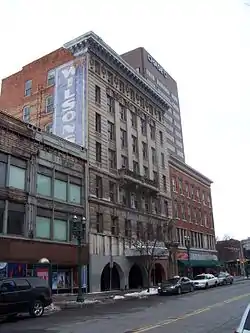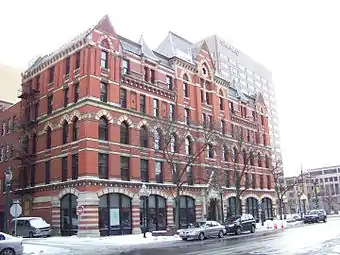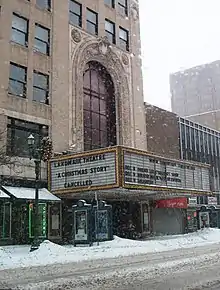South Salina Street Downtown Historic District
South Salina Street Downtown Historic District is a historic district representing what was the commercial core of in Syracuse, New York from the mid-nineteenth century to the mid-twentieth century. It was listed on the National Register of Historic Places on October 16, 2009. The vacancy rate in the district is high, and some buildings need extensive rehabilitation. Recent revitalization plans served as impetus for seeking listing on the National Register of Historic Places.[2]
South Salina Street Downtown Historic District | |
 Wilson Building | |
| Location | 200, 300, & E. side of 400 blocks of Warren, 205-209 Jefferson, 400 blk. & 500-550 S. Salina Sts, Syracuse, New York |
|---|---|
| Area | 9.3 acres (3.8 ha)[1] |
| NRHP reference No. | 09000832[2] |
| Added to NRHP | October 16, 2009[2] boundary increase May 7, 2014[3] |
Originally it included the east side of the 200 block of South Salina Street, the entire 300 block and one building in the 400 block. This area had 22 contributing buildings and 3 non-contributing buildings.[1] Among the contributing properties are two the White Memorial Building and the Loew's State Theater, also individually listed on the National Register of Historic Places. In 2014 its boundaries were increased to include some more side streets.[3]
Architects represented in the district include Horatio Nelson White, Archimedes Russell, Charles E. Colton, Joseph Lyman Silsbee, Charles D. Wilsey and Thomas W. Lamb.
| Landmark name | Image | Date Built | Style | # of stories | Location | Description | |
|---|---|---|---|---|---|---|---|
| 1 | White Memorial Building |  |
1876 | High Victorian Gothic | 5 | 201 S. Salina Street |
Multi-colored brick, Ohio sandstone, Onondaga limestone; mansard roof; gargoyles; Joseph Lyman Silsbee, architect |
| 2 | Salina Place | c. 1870 | 4 | 205 S. Salina Street |
Three buildings with common cornice; southern building rebuilt 1914 | ||
| 3 | McCarthy Building |  |
1894 | Italian Renaissance Revival | 7 | 217 S. Salina Street |
Beige brick; bracketed eaves; decorative lintels; Charles E. Colton, architect |
| 4 | Woolworth Building | 1941 | Art Deco | 2 | 301 S. Salina Street |
Tile and brick; flat roof | |
| 5 | Dollarwise Building | 1856; 1915 | Federal | 5 | 313-315 S. Salina Street |
Brick; medallion supported eaves | |
| 6 | Label Shopper Building | c. 1915 | 5 | 317-319 S. Salina Street |
Steel framed; brick; bracketed eaves; decorative details | ||
| 7 | Park-Brannock Building | c. 1856 | Italianate | 5 | 321 S. Salina Street |
Modernized 1930s; clad in cast stone; housed shoe store where Brannock device for measuring feet was manufactured | |
| 8 | Lee's Express | 19th century | Italianate, facade covered | 5 | 323 S. Salina Street |
Brick; historic material covered | |
| 9 | Peatfield Building | c. 1900 | 5 | 325 S. Salina Street |
Marble facade; sculptural figures; formerly Syracuse Trust Company and Marine Midland Bank | ||
| 10 | Lerners Building | Early 20th century | 5 | 327-329 S. Salina Street |
Masonry; white tile; modernized 1950s | ||
| 12 | Dey Brothers Building |  |
1893 | Italian Renaissance Revival | 6 | 401 S. Salina Street |
Grey brick; terra cotta trim; decorative cornice and parapet; Archimedes Russell, architect |
| 14 | Mason Building | 1899 | Italian Renaissance Revival | 6 | 128 E. Genesee Street |
Brick; keystone window lintels; large pilasters; floral decorated frieze; bracketed cornice | |
| 15 | Witherill Building | 1855 | Italianate | 4 | 300-304 S. Salina Street |
Brick; Syracuse High School 1856-1861; Bryant & Stratton 1870s & 1880s; Henry Pike, architect | |
| 16 | Wilson Building |  |
1898 | Beaux Arts | 7 | 306-312 S. Salina Street |
Brick and cast stone; bracketed balcony; copper cornice; originally known as the Dillaye Memorial Building; Charles E. Colton, architect |
| 17 | Bond Building (originally part of the Butler Block - separated c. 1920) | c. 1878, c. 1920 | 3 | 320-324 S. Salina Street |
Double width; flat roof; copper sheathing; Horatio Nelson White, architect; later modifications by Charles D. Wilsey | ||
| 19 | Betts Building (originally part of the Butler Block - separated c. 1920) | c. 1878, c. 1920 | 3 | 320-324 S. Salina Street |
Masonry; flat roof; classical detailing; large pilasters; Horatio Nelson White, architect | ||
| 18 | Nu-Look Building (originally part of the Butler Block - separated c. 1920) | c. 1878, c. 1920 | 3 | 326 S. Salina Street |
Flat roof; copper sheathing; simple parapet; Horatio Nelson White, architect; later modifications by Charles D. Wilsey | ||
| 20 | Loew's State Theater (a.k.a. Landmark Theatre) |  |
1928 | 8 | 362-374 S. Salina Street |
Masonry and light stone; three-story arched window above marquee; 21 storefronts, 160 offices; 3,300-seat theater; individually listed 1977; designed by Thomas W. Lamb |
See also
- South Salina Street Historic District, also NRHP-listed, further down the same street
- National Register of Historic Places listings in Syracuse, New York
References
- Anthony Opalka and Cynthia Carrington Carter (August 2009). "National Register of Historic Places Registration: South Salina Street Downtown Historic District". New York State Office of Parks, Recreation and Historic Preservation. Retrieved 2010-05-16. and Accompanying 13 photos, from 2009 (see captions on page 23 of text document)
- "Announcements and actions on properties for the National Register of Historic Places for February 5, 2010". Weekly Listings. National Park Service. February 5, 2010. Retrieved 2010-05-16.
- "Announcements and actions on properties for the National Register of Historic Places for May 16, 2014". U.S. National Park Service. May 16, 2014. Retrieved May 16, 2014.